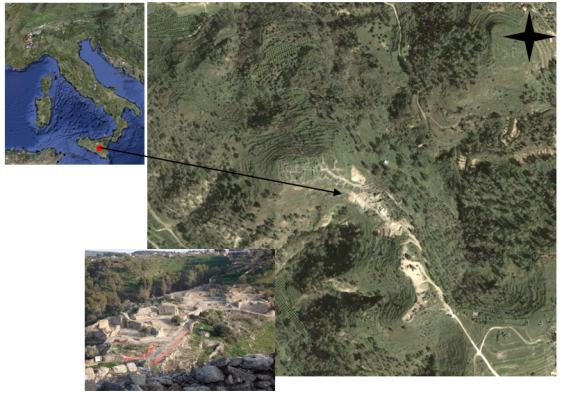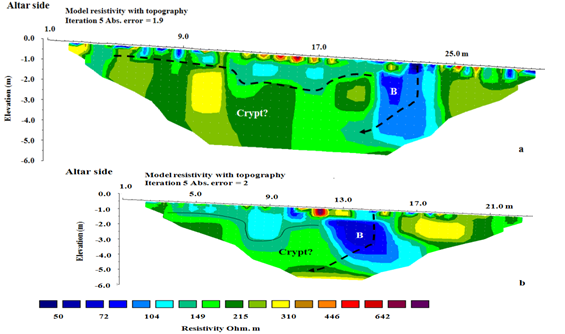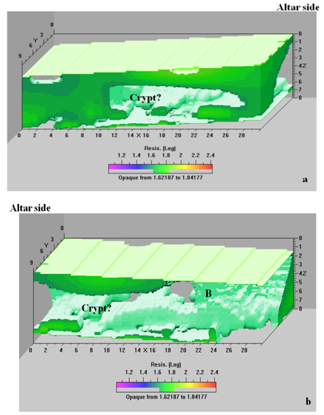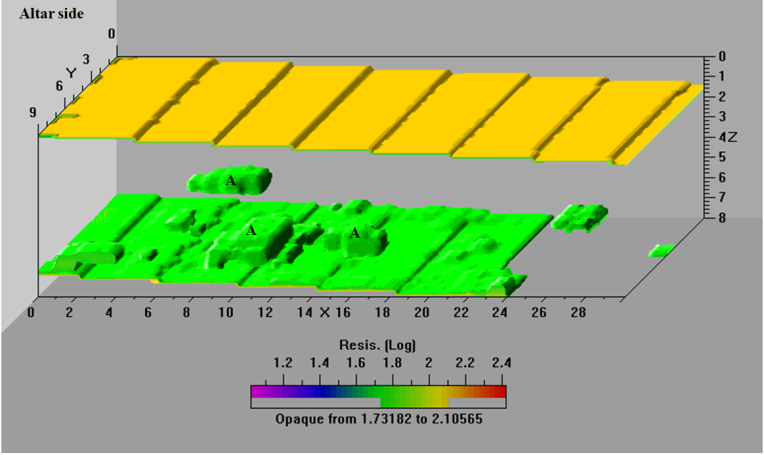-
Paper Information
- Paper Submission
-
Journal Information
- About This Journal
- Editorial Board
- Current Issue
- Archive
- Author Guidelines
- Contact Us
Archaeology
2012; 1(1): 1-6
doi: 10.5923/j.archaeology.20120101.01
3D ERT Survey to Reconstruct Archaeological Features in the Subsoil of the “Spirito Santo” Church Ruins at the Site of Occhiolà (Sicily, Italy).
1Institute for Archaeological and Monumental Heritage (National Research Council), Lecce, 73100, Italy
2Istituto Nazionale di Geofisica e Vulcanologia (INGV) - Sezione di Catania, Osservatorio Etneo, Catania, 95125, Italy
Correspondence to: Leucci G. , Institute for Archaeological and Monumental Heritage (National Research Council), Lecce, 73100, Italy.
| Email: |  |
Copyright © 2012 Scientific & Academic Publishing. All Rights Reserved.
Three-dimensional Electric Resistivity Tomography (ERT) was undertaken at the archaeological site of Occhiolà (Sicily, Italy) a medieval village, located on the north western part of a hill named “Terravecchia” at 491 m above sea level. The survey was carried out inside the ruins of “Spirito Santo” Church. This paper presents the geophysical results of the 2004 campaign that aimed at exploring the buried extension of the possible crypt and/or tombs inside the church. ERT survey was performed by means of Molisana Apparecchiature Elettroniche (MAE) system with 31 active electrodes. The dipole-dipole array was selected for measurements. Resistivity variations are known to correlate well with the lithological nature of the earth materials, thus providing important information in order to locate buried archaeological remains. The electrical data were visualised in a three-dimensional space by using the iso – resistivity surface. This allowed the three-dimensional position of the anomalies evidenced in the single electrical section in a more effective manner. The results obtained in the survey highlight the presence of regular shape structures probably due to features of archaeological interest.
Keywords: Archaeology, Electrical Resistivity Tomography, 3D Visualization
Article Outline
1. Introduction
- The application of geo-archaeological and geophysical methods changed the starting point of scientific approaches toward archaeological investigations in the 20th century. Traditional methods used in archaeology gave limited or sometimes no information on unexcavated subsurface archaeological features. The application of geophysics to archaeology dates back to the early 1950s. The rapidly evolving technology over the past 20 years has made the geophysical approach a reliable investigative tool, both before and during excavation. Geophysical prospecting allows the physical parameters of the subsoil to be mapped in large-scale reconnaissance surveys. In specific cases, it can provide useful information on the depth and shape of buried structures of anthropogenic origin and may help detect individual artefacts. One of the most commonly applied techniques of geophysical surveying is the electrical resistivity tomography (ERT) that provide the measurement of the specific electrical resistance of soil (Mol and Preston, 2010; Papadopoulos and Sarris, 2011; Tsourlos and Tsokas, 2011).ERT method is suitability in detecting walls, cavities and other structures at differing depths (Monteiro and Senos Matia 1987; Ponti et al. 1996; Thacker and Ellwood 2002; Dogan and Papamarinopoulos 2003; Senos Matias 2003; Leucci 2006; Papadopoulos et al. 2006; Gaffney, 2008; Leopold et al., 2010; Papadopoulos et al., 2010; Leopold et al. 2011).The use of resistivity in identification of walls has long been a common practice (Sarris and Jones 2000; Drahor et al., 2008; Tsokas et al., 2008; Tsokas et al., 2009; Berge et al., 2011).This paper shows the results of a geoelectrical survey performed in a high earthquake risk area inside the village of Occhiolà (Sicily Region, south Italy; Fig. 1), where the imposing ruins of a castle and part of the original urban plan, are still presents (Fig. 1).
 | Figure 1. Map showing the location of Occhiolà village (Sicily, Italy). |
2. ERT Survey Planning and Method
- The ERT investigation was carried out using a multi-electrode resistivity system with a dipole–dipole array along a total of 10 profiles. The dipole-dipole array was chosen because, as is well known, it is very sensitive to horizontal changes in resistivity and is therefore appropriate in mapping vertical structures (Loke 2009).Parallel profiles at a mutual distance of about 1 meter were arranged (Fig. 2). A 31-electrode layout with a dipolar spread of 1 meter was used for the E3,…E8 profiles, with a total length of the profiles equal to 30 meters. A 23-electrode layout with a dipolar spread of 1 meter was used for the E1, E2, E9 and E10 profiles, with a total length of the profiles equal to 22 meters. A3000-E, resistivity-meter from M.A.E. (Molisana Apparecchiature Elettroniche) instruments in multi-electrode configuration was used to collect the apparent resistivity data.
 | Figure 2. Surveyed area. The imposing ruins of the Santo Spirito Church are shown in the photo. On the right the plant of the church. |
 | (1) |
2.1. ERT Data Processing and Results
- The first step in the data processing consists of obtaining a pseudo-section by plotting the apparent resistivity versus the depth for each midpoint of a given electrode configuration. The inversion of the data is carried out according to an iterative process which aims at minimising the difference between the measured pseudo-section and the calculated pseudo-section based on a starting model. This model is updated after each iteration until it reaches an acceptable agreement between measured and calculated data or until no further improvements are possible. The Res3dinv resistivity inversion software (Loke 2001) was used to automatically invert the apparent resistivity acquired data and to yield a three-dimensional resistivity model. The “smoothness-constrained robust” inversion method, presented by Loke and Barker (1996), was applied. This method, minimising the absolute value of the sum of differences, between measured and calculated resistivity values, produces models with fast transitions across areas of different electrical values, so that even if strong lateral or vertical resistivity variations occur (such as in an archaeological area) this method can be considered suitable.
 | Figure 3. Pseudo-sections across the E8 (a) and E9 (b) profiles. |
 | Figure 4. 3D contouring of iso-resistivity surfaces using a threshold value ranging from 40 to 65 Ω m. |
 | Figure 5. 3D contouring of iso-resistivity surfaces using a threshold value ranging from 50 to 125 Ω m. |
3. Conclusions
- The archaeological area of Occhiolà (Sicily region, Italy) includes clear evidences showing that the site has been occupied since the XI-X century b.C., until 11 January 1963, when a catastrophic earthquake that destroyed many towns of eastern Sicily occurred. In order to map the archaeological structures at the ruins of Occhiolà village, electrical resistivity tomography (ERT) method was used.We have shown the results from an application of this geophysical method to a case study of great importance from an archaeological point of view, namely the Santo Spirito Church. As outlined in previous applications, the 3D ERT can be considered a self-sufficient procedure, useful to delineate location and shape of the anomalies detected from the ground surface. Electrical surveys, effectively visualized as iso-resistivity surfaces, allow the localization of anomalies leading to buried archaeological remains (probably crypts and tombs) beneath the ruins of the church. Indeed, relatively high resistivity anomalies could be due to the collapsed crypt. It is likely that the 1693 earthquake caused the crypt collapse.To date the three dimensional reconstructed source images cannot be compared with the available historical and archaeological information since systematic archaeological excavation was not applied at this site.Therefore, a rapid scientific and non-destructive technique was needed to delineate any buried archaeological remains in order to rescue them from being lost forever. We hope that the results of this study could encourage future archaeological excavation.
ACKNOWLEDGEMENTS
- This work is dedicated to a great friend and estimated colleague Dr Geologist Gaetano Alia (1962-2009), died prematurely.
 Abstract
Abstract Reference
Reference Full-Text PDF
Full-Text PDF Full-Text HTML
Full-Text HTML